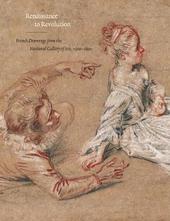
|
Renaissance to Revolution: French Drawings from the National Gallery of Art, 1500-1800
Hardback
Main Details
| Title |
Renaissance to Revolution: French Drawings from the National Gallery of Art, 1500-1800
|
| Authors and Contributors |
By (author) Margaret Morgan Grasselli
|
| Physical Properties |
| Format:Hardback | | Pages:319 | | Dimensions(mm): Height 305,Width 241 |
|
| Category/Genre | Drawing and drawings
Exhibition catalogues and specific collections |
|---|
| ISBN/Barcode |
9781848220430
|
| Classifications | Dewey:709.440903 |
|---|
| Audience | | Professional & Vocational | |
|---|
| Edition |
New edition
|
| Illustrations |
Includes 260 colour illustrations
|
|
Publishing Details |
| Publisher |
Lund Humphries Publishers Ltd
|
| Imprint |
Lund Humphries Publishers Ltd
|
| Publication Date |
28 October 2009 |
| Publication Country |
United Kingdom
|
Description
One of the glories of the National Gallery of Art's holdings is its outstanding collection of French old master drawings, which represents in remarkable richness and breadth the history of French draftsmanship before 1800. Though individual works have appeared in countless exhibitions at the Gallery and elsewhere, the heart of the collection as a whole, now augmented with numerous important recent acquisitions, has never before been featured in a special exhibition or a comprehensive catalogue. "Renaissance to Revolution" presents a selection of the Gallery's most significant, beautiful, and representative drawings from three centuries, offering a visual exploration of the development of graphic art in France, from its first flowering during the Renaissance through to its neoclassical incarnation during the political and social upheavals of the French Revolution. The earliest work in the book is a rare and exquisite landscape watercolor dating from about 1500 by the miniaturist Jean Poyet, who worked for Queen Anne de Bretagne; one of the last is a neoclassical portrait from 1795 by Jacques-Louis David, who was an intimate participant in the Revolution. This book encompasses all the major stylistic trends, from the affectations of the school of Fontainebleau in the sixteenth century, through the grand manner under Louis XIV, to the frothy effervescence of the eighteenth-century rococo, and finally, the return to sober classical ideals in the late 1700s. At the same time, this rich panoply of works, executed in a wide variety of techniques, covers a remarkable range of genres, including book illustrations, compositions, landscapes, portraits, architectural studies and capriccios, and figure drawings. The selection reveals in impressive fashion the strength and scope of the Gallery's collection, while also celebrating the singular originality, elegance, and spirit of French draftsmanship.
Author Biography
Margaret Morgan Grasselli is curator of old master drawings at the National Gallery of Art and an internationally recognised expert on French drawings. Her publications include Colorful Impressions: The Printmaking Revolution in Eighteenth-Century France (National Gallery of Art/Lund Humphries, 2003); she co-authored Private Treasures: Four Centuries of European Master Drawings (National Gallery of Art/Lund Humphries, 2007).
Reviews'... thoroughly researched catalogue ... By bringing the holdings of French drawings at the National Gallery into the spotlight, Renaissance to Revolution presents a collection which ... has attained an impressive level of maturity'. The Burlington Magazine January 2010 ' ... strong in scope and quality, many beautiful and important drawings are featured, including acquisitions never exhibited before ... with beautiful color illustrations and scholarly documentation, this is recommended for readers interested in the subject of old master drawings and French drawings in particular.' Library Journal '...this magnificent catalogue with its exquisite reproductions...entries are accessibly written, and comparative works are usefully illustrated...provides an interesting history of how the collection gradually acquired its current renown. Summing Up: Highly recommended.' Choice 'The book will appeal to anybody interested in drawing and French history.' Arlis
|